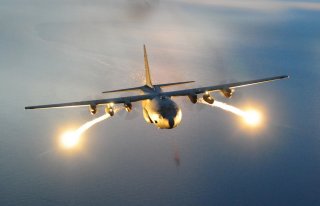The Air Force Wants Its Entire Force to Carry Hypersonic Missiles
The Pentagon is trying to play catch up with the Russian and Chinese militaries.
Here's What You Need to Remember: Although hypersonic weapons are already being prototyped and test-fired, manufacturing hypersonics brings substantial technical challenges, many weapons developers explain. They require very precise engineering to manage propulsion, temperature, and target guidance, among other things.
The Air Force is now ready to arm its force with fast-emerging hypersonic weapons, keeping pace with the service’s plan to fast-track the high-speed missiles to war.
Live fire exercises are slated to begin shooting prototypes of the Lockheed-built AGM-183A Air-Launched Rapid Response Weapon (ARRW), according to a June 3 report in The Drive. The Air Force plans to purchase eight prototypes, the paper said. The Air Force previously conducted a captive carry test flight of the ARRW on a B-52 last year. The service has also configured a B-1B bomber with hypersonic weapons as well.
Accommodating hypersonic weapons into a B-52 pr B1 bomb-bay brings a number of strategic implications. Not only does it massively increase the target envelope and range, but it also allows for longer mission “dwell” time over targets to sustain attacks.
Last year, the Air Force demonstrated arming its B1-b bomber with hypersonic weapons as well, as a way to plan for the future and prepare the classic platform for a new generation of attack options. Integrating large hypersonics also merges with the Air Force’s broader intent to merge innovations more quickly from the Science and Technology realm into operational use. A new S&T Air Force strategy, released earlier last year, emphasizes greater synergy between scientifically-oriented weapons breakthroughs and “bending” metal on prototypes and systems in preparation for operational combat use.
“The S&T strategy articulates five different areas of strategic capabilities to address as an enduring military problem. One of those is speed and reach of disruption and lethality. One of the ways to address this is through hypersonics as a tool in the toolbox for operators,” Tim Sakulich, Executive Lead for Implementing the Air Force S&T Strategy, Air Force Research Lab, told TNI in an interview last year.
Although hypersonic weapons are already being prototyped and test-fired, manufacturing hypersonics brings substantial technical challenges, many weapons developers explain. They require very precise engineering to manage propulsion, temperature and target guidance, among other things. A missile traveling at five times the speed of sound brings never-before-seen dynamics to weapons production. Finding the right materials, Sakulich explained, is crucial.
“From a materials and manufacturing standpoint, we are contributing to the hypersonics capability base by looking at materials and processes that will enable designers to demonstrate these kinds of future capabilities and make them affordable. This includes looking at composites and materials for thermal management,” Sakulich, who also serves as the Director of Materials and Manufacturing, Air Force Research Lab, told TNI during the interview.
Last year, Raytheon Hypersonic weapons developer Dr. Thomas Bussing, who is the Vice President at Raytheon Missile Systems, told TNI “you can model and measure the heat in the vehicle and you can measure the material properties.” He also said, “You can’t test range (with a ground test), but you can measure performance, lift of the vehicle and thrust, attributes from which you can infer range,” referring to hypersonic weapons experiments.
The ARRW is a “boost glide” weapon which achieves speed and range by “skipping off the upper atmosphere,” Bussing said. They can be a winged glider or take on a canonical shape, making them maneuverable and high-speed with a high “lift over drag ratio.”
Boost-glide hypersonic weapons, Bussing explained, “propel a glide vehicle to a point in space where it has a certain altitude and a certain forward speed.” The speed of descent then propels the weapon toward its target.
Interestingly, in a manner consistent with Sakulich’s comments, a Raytheon essay on hypersonics cites “thermodynamics” or “heat” management as essential to the effort. Objects, such as weapons, traveling at hypersonic speeds naturally generate a massive amount of heat which must be properly managed for the weapon to function. Specific materials designed to withstand high temperatures need to be used as well, Raytheon data states. One of the greatest challenges with hypersonics is what the Raytheon paper refers to as the “effects chain”—the command and control, networking and sensor technology sufficient to achieve the requisite guidance, targeting and precision flight.
Air-Breathing systems regularly use a scramjet engine to generate thrust—and propel the air vehicle across long distances to a target. While engineered to reach previously unattainable levels of propulsion, scramjet engine technology aligns with the technical configuration of existing high-power engine systems. This includes taking in a high-speed air flow, compressing the air and then igniting it with gas or some kind of propellant to generate thrust.”
Kris Osborn is the new Defense Editor for the National Interest. Osborn previously served at the Pentagon as a Highly Qualified Expert with the Office of the Assistant Secretary of the Army—Acquisition, Logistics & Technology. Osborn has also worked as an anchor and on-air military specialist at national TV networks. He has appeared as a guest military expert on Fox News, MSNBC, The Military Channel, and The History Channel. He also has a Masters Degree in Comparative Literature from Columbia University. This first appeared earlier and is being reposted due to reader interest.
Image: Flickr.

